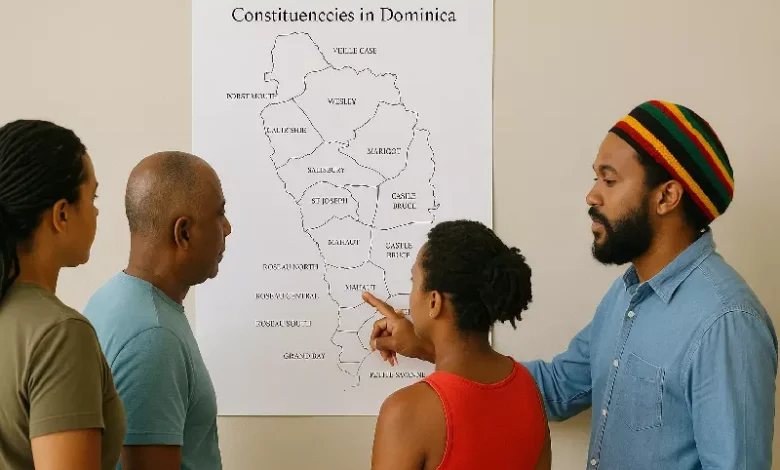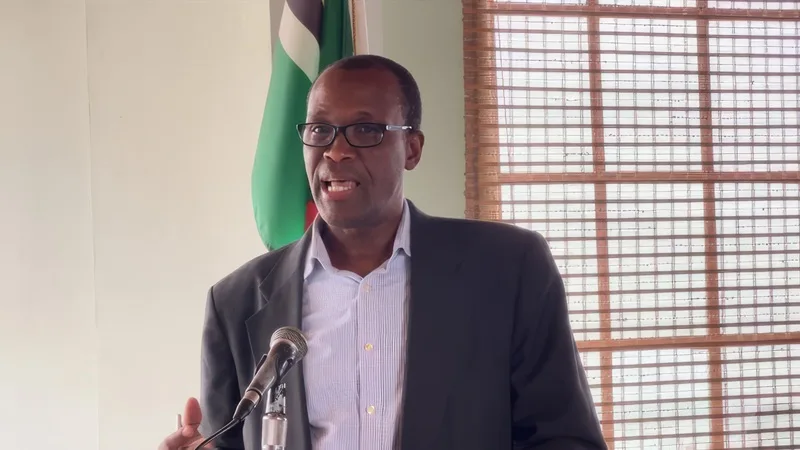Constituencies in Dominica

Constituencies in Dominica form the electoral foundation of the country’s parliamentary democracy. Each constituency is a defined geographic area that elects one Member of Parliament (MP) to represent its people in the House of Assembly. These constituencies serve as the basis for general elections and administrative and development units through which national priorities are localised and executed.
Established under the 1978 Constitution of Dominica, the current framework of 21 single-member constituencies results from decades of political evolution. Before independence, Dominica’s representation developed through various stages of limited franchise and appointed governance under colonial rule. The introduction of universal adult suffrage in 1951 marked a turning point, expanding democratic participation and strengthening local political identity. Today, each constituency is a gateway for public services, community engagement, and national planning.
The Electoral Boundaries Commission oversees the demarcation of constituencies, ensuring that the division of electoral districts remains fair, population-balanced, and geographically coherent. This is crucial in a small island state like Dominica, where urban, rural, and Indigenous populations all demand adequate political representation and access to resources.
Current Parliamentary Constituencies of Dominica
The following is a list of all 21 parliamentary constituencies in Dominica, each describing its geographic coverage, key communities, and the currently elected Parliamentary Representative. This structure provides a snapshot of Dominica’s electoral map and helps illustrate how national governance is grounded in local representation.
- Castle Bruce Constituency: Includes Castle Bruce, Good Hope, San Sauveur, and Petite Soufrière on the east coast. Represented by Octavia Alfred of the Dominica Labour Party (DLP), the area is known for agriculture, rural communities, and connections to the central forest reserve.
- Colihaut Constituency: Covers Colihaut, Dublanc, and Bioche on the northwest coast. Represented by Daren Pinard, this constituency is shaped by coastal fishing culture and community ties, with infrastructure improvements linked to climate resilience and post-storm reconstruction efforts in recent years.
- Cottage Constituency: Encompasses Cottage, Toucari, Clifton, and Lagoon. Represented by Roland Royer of the DLP, it borders the northern tip of Dominica, historically significant for agriculture, strong community roots, and regional trade along Dominica’s Atlantic and Caribbean coasts.
- Grand Bay Constituency: Covers Grand Bay, Montine, and Bordieux. Known as “South City,” Grand Bay has long been a political hub and represented by Dr. Vince Henderson. The area blends activism, cultural strength, and historical community pride.
- La Plaine Constituency: Includes La Plaine, Delices, and Boetica in the southeast. Represented by Cassandra Williams, Minister for Health. Known for rugged landscape, waterfalls, and landslide-prone zones, the constituency is noted for farming and challenges linked to road access.
- Mahaut Constituency: Contains Mahaut, Canefield, Campbell, Checkhall, Roger, Springfield, Tarreau, Warner and Massacre along the west coast. Represented by Cassanni Laville, this highly developed constituency sits near Roseau and includes key industrial and residential zones with close access to Dominica’s road and shipping infrastructure.
- Marigot Constituency: Centred around Marigot and Melville Hall in Saint Andrew Parish. Represented by Anthony Charles. Historically active in politics, it includes the Douglas-Charles Airport and serves as a gateway to northeast agricultural districts.
- Morne Jaune/Riviere Cyrique Constituency: Covers Grand Fond, Riviere Cyrique, and Morne Jaune in the southeast. Represented by Gretta Roberts, this mountainous constituency is focused on farming, strong local identity, and landslide mitigation due to terrain vulnerability and weather exposure.
- Paix Bouche Constituency: Includes Anse de Mai, Paix Bouche, Calibishie and Hampstead. Represented by Lakeyia Joseph, the area spans both fishing villages and agricultural lands in northern Dominica, with community development programs centered around entrepreneurship and youth.
- Petite Savanne Constituency: Includes Bellevue Chopin, Bagatell, Fond Saint Jean, and the relocated Petite Savanne community. Represented by Jullan Defoe, it is an area deeply affected by Tropical Storm Erika, with many resettled residents and active involvement in disaster recovery programs.
- Portsmouth Constituency: Covers Glanvillia, Portsmouth, Dos D’Ane and Bornes. Represented by Fenella Wenham-Sheppard. It is a commercial and educational center with a hospital, secondary schools, and growing ties to tourism and yachting on the northwest coast.
- Roseau Central Constituency: Dominica’s capital center, including the main business district. Represented by Melissa Poponne-Skerrit, this urban constituency includes Parliament, government offices, and local markets and is heavily targeted for urban beautification and housing projects.
- Roseau North Constituency: Covers Pottersville, Goodwill, Fond Cole and Morne Daniel. Represented by Miriam Blanchard of the DLP. This mixed-use area includes a prison, residential zones, and educational institutions, bridging Roseau with northern parishes through its vital infrastructure.
- Roseau South Constituency: Includes Bath Estate, Elmshall, Giraudel, Kings Hill, Morne Bruce, Newtown and Loubiere. Represented by Chekira Lockhart-Hypolite, the constituency balances housing expansion with coastal risks. It includes part of the road to the Roseau Valley and tourism-oriented districts.
- Roseau Valley Constituency: Encompasses Cochrane, Laudat, Trafalgar, Wotten Waven and Morne Prosper define this geothermal-rich constituency. Represented by Dr. Irving McIntyre, it is central to tourism, hot springs, and Climate conservation efforts under national climate adaptation programs.
- Salisbury Constituency: Includes Morne Rachette, Coulibistrie, Salisbury. Represented by Jesma Paul-Victor, one of two independents. The west coast area is known for its resilient communities and agricultural output, including banana and root crop production.
- Salybia Constituency: Covers the Kalinago Territory; Bataka, Atkinson, Crayfish River, Sineku, Salybia. Represented by Cozier Frederick, who focuses on Kalinago Upliftment and indigenous rights. The area includes heritage-centred eco-tourism development projects.
- St. Joseph Constituency: Comprises St. Joseph, Layou, and Mero. Represented by Darron Lloyd, it spans agricultural valleys and coastal development. It is central to Dominica’s West Coast resilience plans and ongoing Tourism Industry investment.
- Soufriere Constituency: Includes Soufrière, Scotts Head and Galion. Represented by Denise Charles-Pemberton, the constituency is a southern tourism hub. It includes volcanic features, snorkelling zones, and the southern entrance to the Caribbean Sea.
- Vieille Case Constituency: Covers Vieille Case, Thibaud, and Penville. Represented by Prime Minister Roosevelt Skerrit, the constituency is located in the island’s far northeast. Known for scenic cliffs and historic villages, it receives continuous infrastructure focus.
- Wesley Constituency: Includes Wesley and Woodford Hill near the Douglas-Charles Airport. Represented by Fidel Grant, this northeast seat plays a key role in air access and rural modernisation under Dominica’s Digital Economy initiatives.
Constituencies and Democratic Access
Constituencies remain essential to Dominica’s democratic stability and local governance. They not only empower voters during elections but shape the flow of development projects, disaster response, and public engagement year-round. A well-represented constituency ensures that government remains visible, accessible, and accountable at the community level.




